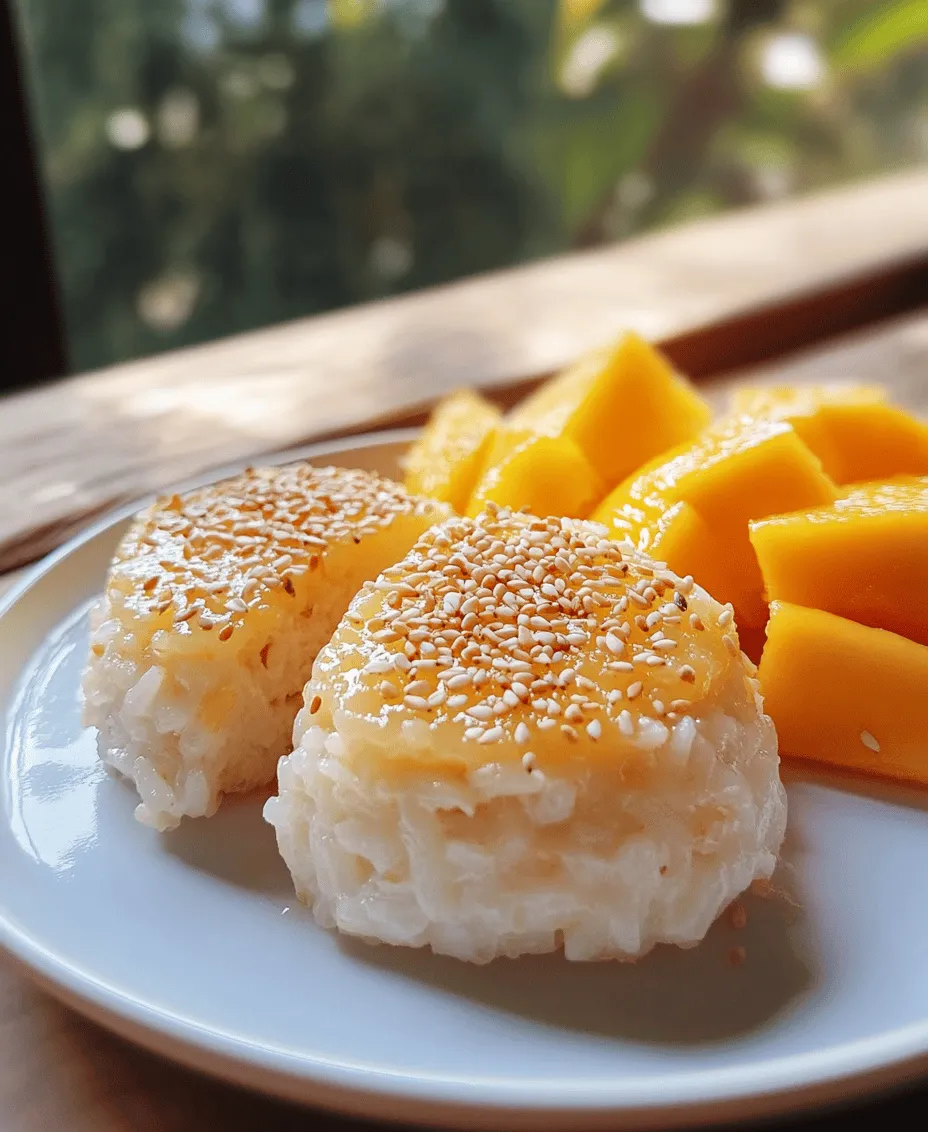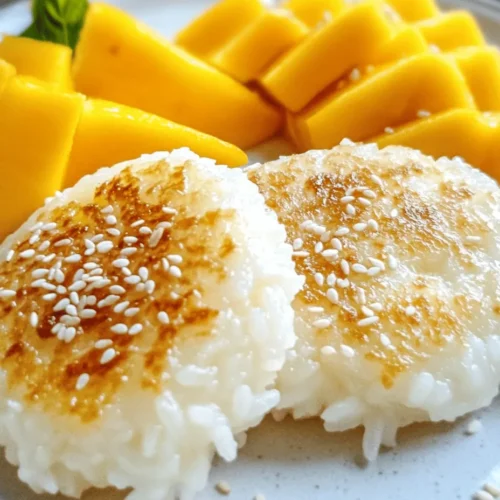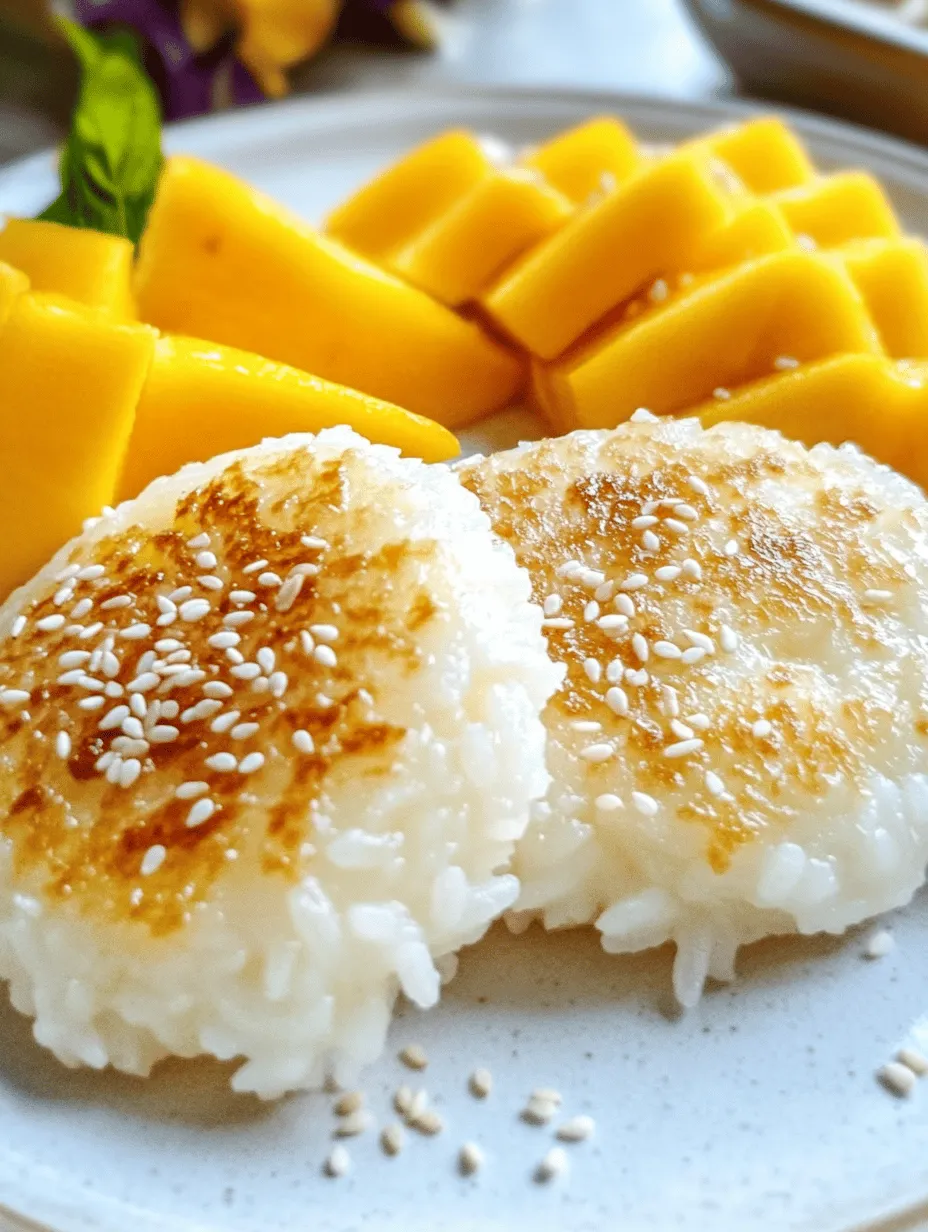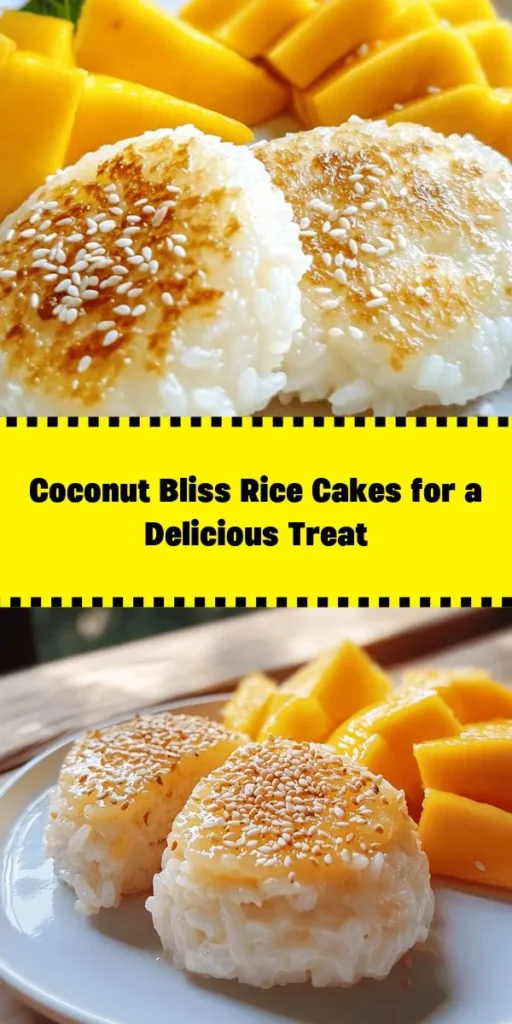Introduction
In the realm of comfort food, few dishes evoke the same sense of satisfaction and delight as Coconut Bliss Rice Cakes. This recipe, infused with the tropical essence of coconut and the subtle sweetness of jasmine rice, presents a deliciously unique take on traditional rice cakes. Not only are these cakes simple to prepare, but they also cater to various dietary preferences, making them perfect for family gatherings or quiet afternoons at home.
The appeal of Coconut Bliss Rice Cakes lies in their ability to seamlessly blend familiar flavors with a hint of exotic flair. Whether enjoyed as a snack, a dessert, or a delightful addition to brunch, these rice cakes offer a versatile option that can be tailored to different tastes. As we embark on this culinary journey, we’ll explore the world of Coconut Bliss Rice Cakes, from their intriguing ingredients to the step-by-step process of creating this delightful dish.
Understanding the Inspiration Behind Coconut Bliss Rice Cakes
Exploring the Cultural Significance of Rice Cakes
Rice cakes have a rich history across various cultures, serving as both a staple food and a celebratory dish. From the crunchy rice cakes of East Asia to the soft and fluffy varieties found in Indian cuisine, rice cakes are a testament to the versatility of this humble grain. They are often made with different types of rice and can be sweet or savory, showcasing the adaptability of rice as an ingredient.
In Southeast Asian cultures, rice cakes are often associated with festivities and special occasions. They symbolize prosperity and are frequently offered as gifts during celebrations. The addition of coconut in many of these recipes not only enhances the flavor but also ties into the region’s agricultural bounty. Coconut is revered for its versatility—from its meat and milk to its oil and water—making it a beloved ingredient in countless culinary traditions.
The Role of Coconut in Various Culinary Traditions
Coconut has established itself as a beloved ingredient in many global cuisines, especially in tropical regions. Its creamy texture and rich flavor profile make it a favorite for both sweet and savory dishes. In Thai cuisine, for instance, coconut milk is a base for curries and desserts alike. In India, coconut is used in chutneys and sweets, while in the Caribbean, it enhances flavors in rice dishes and desserts.
The combination of coconut and rice is particularly noteworthy in Asian cooking, where these two ingredients often come together to create comforting and satisfying meals. Coconut Bliss Rice Cakes take inspiration from these culinary traditions, marrying the delicate fragrance of jasmine rice with the luscious creaminess of coconut. This unique pairing results in a dish that is not only delicious but also a tribute to the global significance of rice and coconut.
The Appeal of Coconut Bliss Rice Cakes
The allure of Coconut Bliss Rice Cakes goes beyond their cultural significance; they are also characterized by a unique flavor profile and delightful texture. The sweetness of coconut complements the subtle nuttiness of jasmine rice, creating a harmonious balance that is both comforting and indulgent. Each bite is a testament to the careful melding of flavors that define this dish.
Moreover, the versatility of Coconut Bliss Rice Cakes makes them an appealing option for various occasions. They can be served as a snack with a cup of tea, as a dessert topped with fresh fruit, or even as a breakfast treat drizzled with honey or maple syrup. The possibilities are endless, allowing for creativity and personalization in presentation and serving.
Ingredients Breakdown
To create the perfect batch of Coconut Bliss Rice Cakes, understanding the ingredients is essential. Each component contributes to the overall flavor, texture, and nutritional profile of the dish. Let’s delve into the key ingredients and uncover their significance.
Jasmine Rice: Characteristics and Benefits
Jasmine rice is a long-grain variety known for its fragrant aroma and slightly sticky texture when cooked. Originating from Thailand, this rice is often preferred for its delicate flavor, which pairs beautifully with coconut. Jasmine rice is also rich in carbohydrates, making it an excellent source of energy. Additionally, it contains small amounts of essential nutrients such as iron and B vitamins.
The unique characteristics of jasmine rice make it ideal for Coconut Bliss Rice Cakes, as it lends a moist and tender crumb while enhancing the overall flavor of the dish. When selecting jasmine rice, look for high-quality grains that are free from impurities to ensure the best results.
Coconut Milk: Nutritional Value and Alternatives
Coconut milk is a creamy liquid extracted from the flesh of mature coconuts. It is a staple ingredient in many tropical cuisines, celebrated for its rich flavor and versatility. Coconut milk is not only delicious but also packed with nutrients, including vitamins C, E, and several B vitamins. It is also a source of healthy fats, particularly medium-chain triglycerides (MCTs), which are known for their potential health benefits.
For those who are lactose intolerant or following a dairy-free lifestyle, coconut milk serves as an excellent alternative to traditional dairy products. When selecting coconut milk for your Coconut Bliss Rice Cakes, opt for full-fat varieties for a richer flavor and creamier texture. If you’re looking for lighter options, low-fat coconut milk can also work, but it may alter the final texture of the rice cakes.
Sugar: Choosing Between Brown and White
Sugar plays a crucial role in enhancing the sweetness of Coconut Bliss Rice Cakes. The choice between brown and white sugar can significantly influence the flavor and color of the finished product. Brown sugar, which contains molasses, imparts a deeper, more caramel-like flavor, while white sugar provides a cleaner sweetness.
For a more complex flavor, consider using brown sugar in your recipe. However, if you prefer a lighter taste, white sugar will suffice. Whatever your choice, be mindful of the quantity, as the sweetness can be adjusted to personal preferences.
Vanilla Extract: Enhancing Flavor
Vanilla extract is a beloved ingredient that enhances the overall flavor profile of many baked goods, including Coconut Bliss Rice Cakes. Its warm, sweet aroma complements the coconut and jasmine rice, creating a fragrant and inviting dish. When selecting vanilla extract, opt for pure vanilla extract for the best flavor. Imitation vanilla may be more affordable but often lacks the depth of flavor found in pure extracts.
Shredded Coconut: Types and Uses
Shredded coconut is an essential component of Coconut Bliss Rice Cakes, providing both flavor and texture. There are several types of shredded coconut available, including sweetened, unsweetened, and toasted varieties. Unsweetened shredded coconut is often the best option for this recipe, as it allows the natural sweetness of the cake to shine through without overpowering it.
Toasted shredded coconut can also be used to add an extra layer of flavor and a delightful crunch. Whichever type you choose, be sure to measure it accurately to maintain the intended balance in the recipe.
Baking Powder: Role in Texture
Baking powder is a leavening agent that helps the Coconut Bliss Rice Cakes achieve a light and fluffy texture. When combined with wet ingredients, baking powder releases carbon dioxide, creating air pockets that expand during baking. This results in a tender cake that is not overly dense.
Be cautious with the amount of baking powder used; too much can lead to an overly airy texture, while too little can result in a heavy cake. Always check the expiration date on your baking powder to ensure optimal performance.
Coconut Oil: Health Benefits and Cooking Properties
Coconut oil is another key ingredient in Coconut Bliss Rice Cakes, contributing to the dish’s richness and flavor. This versatile oil is derived from the flesh of coconuts and is celebrated for its potential health benefits, including its high content of MCTs. These fats are believed to support energy levels and may aid in weight management.
In addition to its health benefits, coconut oil adds moisture and a subtle coconut flavor to the rice cakes. When using coconut oil, opt for virgin or extra-virgin varieties for the best flavor and quality. Melt the oil before incorporating it into your mixture to ensure even distribution.
Preparation Process
Now that we have explored the ingredients, it’s time to dive into the preparation process of making Coconut Bliss Rice Cakes. Follow these step-by-step instructions to create a delightful treat that is sure to impress family and friends.
Step 1: Gather Your Ingredients
Before you begin, ensure you have all of your ingredients measured and ready to go. This includes jasmine rice, coconut milk, sugar, vanilla extract, shredded coconut, baking powder, and coconut oil. Having everything on hand will streamline the cooking process and help you avoid any last-minute scrambles.
Step 2: Prepare the Jasmine Rice
Start by rinsing the jasmine rice under cold water to remove excess starch. This step is crucial for achieving the right texture in your rice cakes. Place the rinsed rice in a pot and add water according to the package instructions. Bring the water to a boil, then reduce the heat to low and cover the pot. Allow the rice to simmer until fully cooked, which usually takes about 15-20 minutes. Once cooked, fluff the rice with a fork and let it cool slightly.
Step 3: Mix the Wet Ingredients
In a separate mixing bowl, combine the coconut milk, melted coconut oil, sugar, and vanilla extract. Whisk the ingredients together until well combined. The coconut milk should be smooth and creamy, and the sugar should be fully dissolved in the mixture. This wet mixture will impart moisture and flavor to the rice cakes.
Step 4: Combine Dry Ingredients
In another bowl, whisk together the jasmine rice, shredded coconut, and baking powder. Ensure that the baking powder is evenly distributed throughout the dry ingredients, as this will help the cakes rise properly during baking.
Step 5: Combine Wet and Dry Mixtures
Gradually add the wet mixture to the dry mixture, stirring gently to combine. Be careful not to overmix, as this can result in dense rice cakes. The batter should be cohesive but still retain some texture from the rice and coconut.
Step 6: Prepare the Baking Dish
Preheat your oven to 350°F (175°C) and prepare a baking dish by greasing it with coconut oil or lining it with parchment paper. This will prevent the rice cakes from sticking and ensure easy removal once baked.
Step 7: Pour the Batter into the Baking Dish
Once the batter is ready, pour it into the prepared baking dish, spreading it evenly with a spatula. Smooth the top to create an even surface, which will help the cakes bake uniformly.
Step 8: Bake the Rice Cakes
Place the baking dish in the preheated oven and bake for approximately 25-30 minutes, or until the edges are golden brown and a toothpick inserted into the center comes out clean. The aroma of coconut will fill your kitchen as the rice cakes bake, making it hard to resist the temptation to sneak a taste before they’re fully cooled.
Step 9: Let the Cakes Cool
Once baked, remove the rice cakes from the oven and allow them to cool in the dish for about 10 minutes. This will help them set properly and make them easier to cut. After cooling, carefully transfer the cakes to a wire rack to cool completely.
Step 10: Slice and Serve
Once cooled, slice the Coconut Bliss Rice Cakes into squares or rectangles, depending on your preference. They can be served warm or at room temperature. Consider pairing them with fresh fruit, a drizzle of honey, or a sprinkle of toasted coconut for added flavor and presentation.
—
With these detailed steps and the knowledge of each ingredient’s role, you are well on your way to creating your very own Coconut Bliss Rice Cakes. Enjoy the process, and savor the delightful flavors that will transport you to a tropical paradise with every bite. Stay tuned for further insights and tips to elevate your culinary experience with this delightful dish.

Rinsing the Rice: Importance of Reducing Starch
Rinsing the rice is a crucial step in the preparation of Coconut Bliss Rice Cakes. By washing the rice before cooking, you effectively remove excess starch that can make the final product gummy and sticky. This ensures that the rice grains remain separate and fluffy, which is essential for achieving the desired texture in the rice cakes. To rinse the rice, place it in a fine-mesh strainer or a bowl, and run cold water over it while gently swishing the grains with your hand. Continue rinsing until the water runs clear, indicating that most of the starch has been washed away. This simple yet effective technique is vital for creating light and airy rice cakes that melt in your mouth.
Soaking: Enhancing Flavor and Texture
Once the rice is rinsed, soaking is the next important step to enhance both the flavor and texture of the Coconut Bliss Rice Cakes. Soaking the rice for at least 30 minutes allows the grains to absorb some water, which helps to soften them and leads to a more even cooking process. Additionally, soaking can enhance the flavor profile, as it allows the rice to absorb any added seasonings, such as coconut milk or vanilla extract, which you might incorporate into the mixture. To soak the rice, simply place it in a bowl with enough water to cover it by at least an inch. After soaking, drain the rice well before cooking.
Cooking the Rice: Achieving Perfect Tenderness
The next step is cooking the rice to perfection. Bring a pot of water to a boil, using a ratio of about 2 cups of water for every cup of rice. Add a pinch of salt to the water for flavor. Once the water is boiling, add the soaked and drained rice, then reduce the heat to low, cover the pot, and let it simmer for about 15-20 minutes. It’s important not to lift the lid during cooking, as this can release steam and affect the cooking process. After the cooking time is up, remove the pot from the heat and let it sit, covered, for an additional 10 minutes. This resting period allows the rice to finish cooking and absorb any remaining moisture, resulting in tender, fluffy rice that is ideal for your Coconut Bliss Rice Cakes.
Fluffing the Rice: Techniques for the Best Results
Once the rice has finished cooking and resting, it’s time to fluff it. This step is essential for breaking up any clumps and achieving the perfect consistency for your rice cakes. Using a fork, gently fluff the rice by lifting and separating the grains without mashing them. This technique helps to aerate the rice, making it light and fluffy, which is crucial for the texture of your Coconut Bliss Rice Cakes. Fluffed rice will mix more uniformly with the other ingredients, ensuring that every bite is consistently delicious.
Prepping the Muffin Tin: Options for Easy Removal
To ensure that your Coconut Bliss Rice Cakes come out of the muffin tin without sticking, proper preparation is key. You can use either a silicone muffin tin or a standard metal tin. If using a metal tin, lightly grease each cup with coconut oil or non-stick cooking spray to prevent sticking. Alternatively, you can line each cup with parchment paper, which makes removal even easier. If you choose to use silicone, there’s no need for additional grease. Prepping the muffin tin correctly will save you time and frustration during the unmolding process, allowing you to present your rice cakes beautifully.
Detailed Instructions for Baking
Combining Ingredients: Achieving the Right Consistency
With your rice cooked and fluffed, it’s time to combine it with the other ingredients. In a large mixing bowl, combine the fluffed rice with coconut milk, shredded coconut, and any sweeteners you choose, such as honey or maple syrup. You may also want to add a touch of vanilla extract for enhanced flavor. Mix the ingredients until well combined, ensuring that the rice is evenly coated with the coconut mixture. The consistency should be moist but not overly wet. If you find the mixture too dry, you can add a little more coconut milk to achieve the desired texture.
Filling the Muffin Tin: Tips for Compacting Rice
Once your ingredients are combined, it’s time to fill the muffin tin. Using a spoon or a measuring cup, scoop the rice mixture into each muffin cup, filling them about three-quarters full. To ensure the rice cakes hold their shape once baked, it’s important to compact the mixture firmly. You can use the back of a spoon or your fingers to press down on the mixture gently, making sure it is tightly packed. This step is crucial; if the mixture is too loose, the cakes may fall apart when unmolded.
Baking Time and Temperature: Ensuring Optimal Results
Preheat your oven to 350°F (175°C) before baking. Place the filled muffin tin in the oven and bake for about 20-25 minutes, or until the tops are golden brown and the edges start to pull away from the sides of the tin. Baking at the right temperature ensures that the rice cakes cook through without burning, allowing them to develop a lovely crust while remaining tender on the inside. Once baked, remove the muffin tin from the oven and let it cool for a few minutes before attempting to remove the rice cakes.
Serving Suggestions
Creative Ways to Enjoy Coconut Bliss Rice Cakes
Coconut Bliss Rice Cakes are versatile and can be enjoyed in various ways. Here are some creative serving suggestions to elevate your experience:
– Pairing with Fresh Mango Slices: The tropical sweetness of fresh mango complements the coconut flavor beautifully. Simply slice ripe mango and serve it alongside or on top of the rice cakes for a refreshing contrast.
– Garnishing with Toasted Sesame Seeds: For an added crunch and nutty flavor, sprinkle toasted sesame seeds over the top of the rice cakes. This not only enhances the visual appeal but also adds a delightful texture to each bite.
– Serving Warm vs. at Room Temperature: While these rice cakes are delightful when served warm, allowing them to cool to room temperature can bring out their subtle coconut flavors even more. Experiment with both options to discover your personal preference.
Nutritional Information
Analyzing the Health Benefits of Coconut Bliss Rice Cakes
Coconut Bliss Rice Cakes not only satisfy your taste buds but also offer several health benefits. Here’s a breakdown of their nutritional profile:
– Caloric Breakdown per Serving: Each rice cake contains approximately 150 calories, making them a satisfying yet light snack option.
– Nutritional Highlights: These rice cakes are rich in carbohydrates due to the rice, providing a quick source of energy. The addition of coconut milk and shredded coconut contributes healthy fats, which can help keep you feeling full longer. Each rice cake also contains a small amount of protein, making them a balanced snack.
– Dietary Considerations: Coconut Bliss Rice Cakes are naturally gluten-free and dairy-free, making them suitable for various dietary preferences. They are a great option for those following a plant-based diet or looking to avoid gluten.
Conclusion
Coconut Bliss Rice Cakes represent a harmonious blend of flavor and texture that can elevate any culinary experience. With their straightforward preparation and delightful taste, they offer an enticing option for both everyday snacks and special occasions. Whether enjoyed on their own or paired with fresh fruits and garnishes, these rice cakes are sure to delight palates and create lasting memories around the dining table. Embrace the tropical flavors and simplicity of this recipe, and let Coconut Bliss Rice Cakes become a new favorite in your kitchen. The joy of cooking can be found in the little things, and these rice cakes are a beautiful reminder of that. Enjoy the journey of creating these delicious treats, and share them with family and friends for a delightful experience that celebrates the flavors of the tropics.



